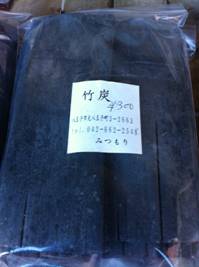 When you think of charcoal, long summer evenings immediately spring to mind, with the smell of sizzling meat or seafood permeating the air. Few people remember, however, that charcoal is so much more than just fuel. It actually has a long tradition of being used in the home as a natural deodoriser and dehumidifier.
When you think of charcoal, long summer evenings immediately spring to mind, with the smell of sizzling meat or seafood permeating the air. Few people remember, however, that charcoal is so much more than just fuel. It actually has a long tradition of being used in the home as a natural deodoriser and dehumidifier.
The method of making Japanese charcoal is unique. Wood from bamboo, hardwood trees or ume seeds is heated to a very high temperature—about 1,000 degrees Celsius—and then allowed to cool in an oxygen-free environment.
The end result is a charcoal that gives off little smoke, while generating heat strong enough for cooking.
Such a high temperature also creates what is called activated charcoal, which has a very porous surface area attractive to other molecules. Charcoal’s normally bottleneck-shaped pores are widened by the heating process, making it easy for wandering molecules to land.
Irresistibly drawn in, such molecules find themselves so busy settling on the surface (a process called adsorption) that they have no energy left to roam about the house being smelly or making mildew.
According to Teresa Bandosz, professor of chemistry and chemical engineering at the City College of New York, who studies the use of activated carbon to help solve environmental problems, one gramme of activated carbon (in this case, charcoal) has a surface area of 1,000–3,000m2.
“Think of a sponge with its many holes. Activated carbon is like that sponge, but rigid with walls made of carbon. The layers are arranged in a disorganised way and between them are the pores. Were you to unfold the layers and lay them out flat, like tiles on a floor, the surface would be immense”, said Bandosz.
That irresistible draw is not just because activated charcoal has so much elbow room on which molecules can land, but also because it is carbon. The element carbon can occur by itself or nearly pure as diamonds or coal, but it is most commonly found combined with other elements to form things such as animals, plants and the soil they grow in—as well as human beings.
Essentially, every living thing contains carbon. And that includes those odours emanating from the rubbish bin or the now unrecognisable leftovers in the back of the refrigerator. What does that have to do with activated charcoal? Simply that carbon, essentially, likes carbon.
“The carbon surface (of charcoal) is able to attract molecules that have carbon. Organic species are made of carbon, so there is a higher affinity and physical attraction”, Bandosz said.
Putting this idea to use in the home is thus a simple matter. For example, charcoal sachets can be hung up in the wardrobe or placed in cupboards to protect clothes from damp, special shoe-shaped forms can be placed in rain-soaked footwear to absorb the moisture and prevent smells, while little bags of charcoal placed on a sofa or in the back of the refrigerator can remove unpleasant odours from the air.
Charcoal used in this way is an extremely effective, environment-friendly alternative to the modern chemical dehumidifiers and deodorisers on offer.
The following charcoal products are available from Eco+waza (www.greenjapan.com). Please e-mail info@ecotwaza.com quoting BCCJ ACUMEN for all information and orders, and to receive bonus points.






Top (left to right): Shoe keeper (small), Hanger, Shoe keeper (large)
Bottom (left to right): Paper, Pyramid, Sachet


